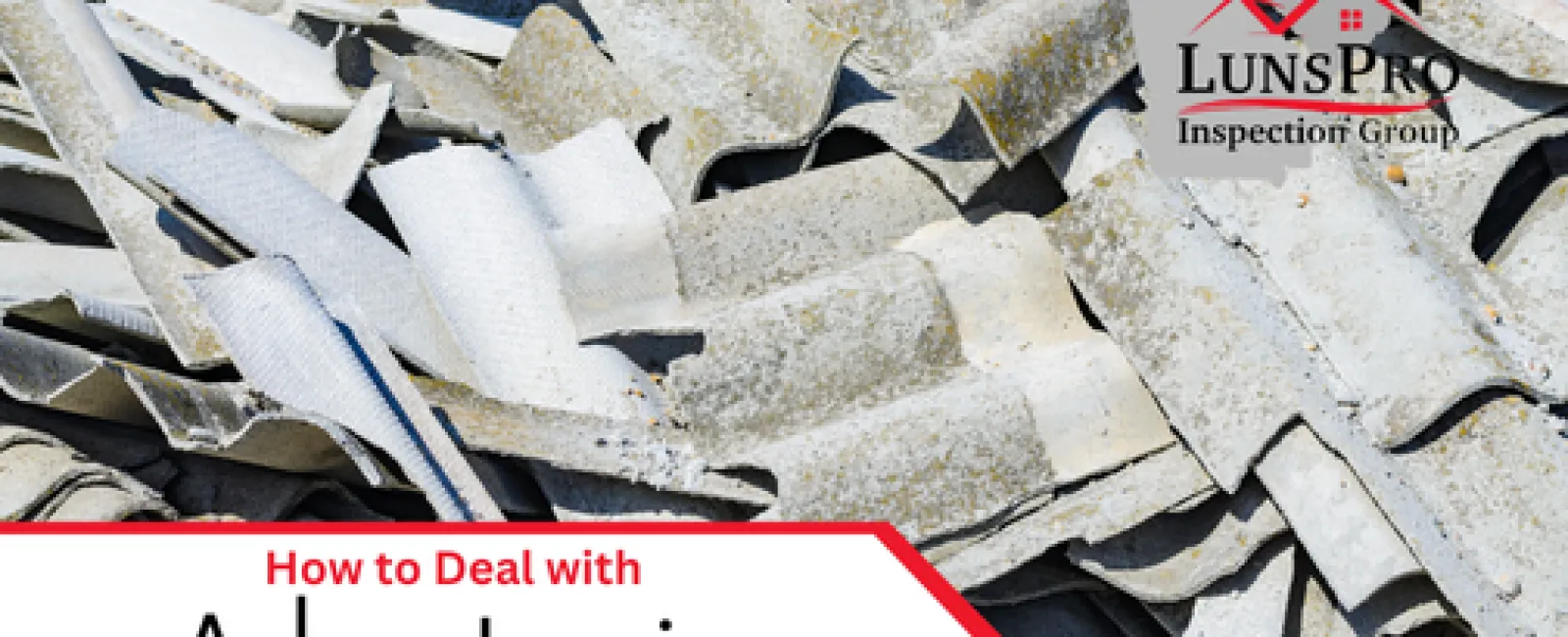The charm of older homes often comes with unique architectural features and a rich history. However, owning or purchasing an older home also comes with its own set of challenges, one of which is the presence of asbestos. Asbestos was widely used in construction materials throughout the 20th century due to its fire-resistant properties and strength. Unfortunately, it was later discovered that asbestos poses significant health risks, leading to serious diseases like mesothelioma and lung cancer.
For homeowners and potential buyers in Atlanta, GA, and the surrounding Atlanta regions, understanding how to deal with asbestos is crucial for maintaining a safe living environment. LunsPro Inspection Group, renowned for its comprehensive Atlanta residential and commercial home inspections, is dedicated to providing the necessary expertise and guidance in handling asbestos issues. In this article, we will delve into the nature of asbestos, how to identify it, the risks it poses, and the steps homeowners should take to address and manage asbestos safely.
Understanding Asbestos and Its Presence in Older Homes
Asbestos is a naturally occurring mineral composed of thin, fibrous crystals. It was extensively used in a variety of building materials including insulation, roofing shingles, floor tiles, and cement products due to its durability and resistance to heat and chemicals. Homes built before the 1980s are more likely to contain asbestos in one form or another.
Identifying Asbestos
Identifying asbestos is not always straightforward, as it is often mixed with other materials and may not be visible to the naked eye. A thorough visual inspection alone is insufficient to confirm its presence; professional testing and analysis are required. Asbestos can pose significant health risks when its fibers are inhaled, making accurate identification crucial. Here are some common places where asbestos might be found, along with additional details:
Insulation:
- Attic Insulation: Particularly in older homes, asbestos-containing vermiculite insulation may be present. This insulation is often found in a loose-fill form and looks like small pebbles.
- Pipe Insulation: Asbestos was commonly used to insulate pipes, especially those in basements and crawl spaces. The insulation is often white or gray and can be found in a corrugated or straight form wrapped around pipes.
Flooring:
- Vinyl Tiles: Asbestos was used in the backing of vinyl floor tiles, typically those measuring 9x9 inches or 12x12 inches. The tiles may be resilient and durable, but if damaged, they can release asbestos fibers.
- Vinyl Sheet Flooring: The backing material of vinyl sheet flooring, installed before the 1980s, often contains asbestos. The backing is usually hidden beneath the top layer and may only be exposed during removal or renovation.
Roofing and Siding:
- Older Shingles: Asbestos was used in roofing shingles to enhance fire resistance and durability. These shingles can appear similar to regular asphalt shingles but contain hazardous fibers.
- Cement-Based Siding: Asbestos-cement siding, commonly known as transite, is a hard, rigid material that was popular for exterior cladding. It typically appears as flat sheets or overlapping boards.
Textured Paints and Patching Compounds:
- Walls and Ceilings: Asbestos was added to some textured paints and patching compounds used on walls and ceilings for its fire-resistant properties. These materials were frequently used to create a "popcorn" or stippled effect on ceilings.
Heat-Resistant Fabrics:
- Older Appliances and Systems: Asbestos was used in various heat-resistant fabrics found in older appliances, such as oven mitts, ironing board covers, and insulation blankets for hot water tanks. These fabrics are designed to withstand high temperatures but can become hazardous if frayed or damaged.
Health Risks Associated with Asbestos
When asbestos-containing materials are disturbed, they release fine fibers into the air. These fibers, when inhaled, can lodge in the lungs and other tissues, causing inflammation and scarring over time. This can lead to several serious health conditions, including:
- Mesothelioma: A rare and aggressive cancer affecting the lining of the lungs, abdomen, or heart.
- Lung Cancer: Prolonged exposure increases the risk of lung cancer.
- Asbestosis: A chronic lung disease causing lung tissue scarring and breathing difficulties.
Given these risks, it is imperative to handle asbestos with extreme care and to seek professional help when dealing with potential asbestos-containing materials in your home.
Steps to Take When Dealing with Asbestos
1. Professional Inspection and Testing: The first step in managing asbestos is to confirm its presence through professional inspection and testing. LunsPro Inspection Group offers specialized Atlanta mold and air quality testing services, which can include asbestos testing. Utilizing advanced methods and technologies, including Atlanta drone inspections for hard-to-reach areas, our certified inspectors can accurately identify and assess the extent of asbestos contamination.
2. Risk Assessment: Once asbestos is confirmed, a risk assessment should be conducted to determine the condition of the asbestos-containing materials and the potential for fiber release. If the materials are intact and undisturbed, they may pose less risk compared to damaged or deteriorating materials.
3. Management and Monitoring: In some cases, asbestos-containing materials that are in good condition can be left in place and monitored regularly for any signs of damage. This approach minimizes the risk of fiber release.
4. Professional Removal and Abatement: If asbestos-containing materials are damaged or likely to be disturbed, professional removal or abatement is necessary. Attempting to remove asbestos yourself is extremely dangerous and illegal in many areas. LunsPro Inspection Group works with certified asbestos abatement contractors who follow stringent safety protocols to remove and dispose of asbestos safely.
5. Post-Abatement Verification: After asbestos removal, a thorough inspection should be conducted to ensure all asbestos fibers have been properly cleared from the environment. This often involves air quality testing to confirm the absence of airborne asbestos fibers.
Preventive Measures and Maintenance
1. Regular Inspections: Schedule regular inspections with LunsPro Inspection Group to monitor the condition of asbestos-containing materials and ensure they remain undisturbed and intact.
2. Home Maintenance: Maintain your home properly to prevent damage to asbestos-containing materials. This includes avoiding DIY renovations in areas where asbestos might be present.
3. Educate Occupants: Educate all household members about the presence of asbestos and the importance of not disturbing it.4. Utilize Protective Measures: If you must work near asbestos-containing materials, use protective measures such as wearing appropriate personal protective equipment (PPE) and following safety guidelines to minimize exposure.
Dealing with asbestos in older homes requires a careful and informed approach. The health risks associated with asbestos are significant, making it essential for homeowners to rely on professional expertise for inspection, testing, and abatement. LunsPro Inspection Group, with its extensive experience in Atlanta residential and commercial home inspections, is dedicated to helping homeowners in Atlanta, GA, and the surrounding areas manage asbestos safely and effectively.
By understanding the risks, taking appropriate precautions, and seeking professional assistance, you can ensure that your home remains a safe and healthy environment. Whether you're dealing with asbestos or any other home maintenance concerns such as Atlanta septic and sewer scope inspections, Atlanta radon testing, Atlanta mold and air quality testing, Atlanta pool inspections, or general Atlanta home maintenance, trust LunsPro Inspection Group to provide the comprehensive inspection services you need to maintain your home's integrity and safety.

